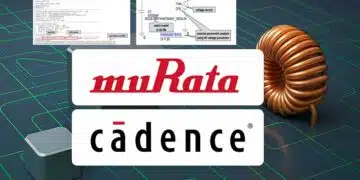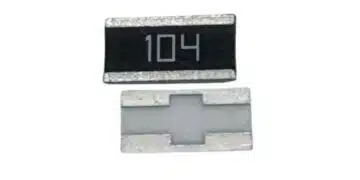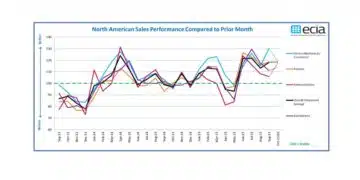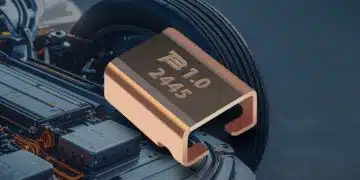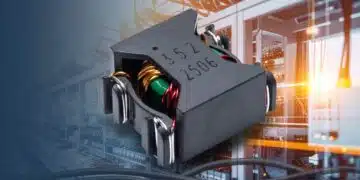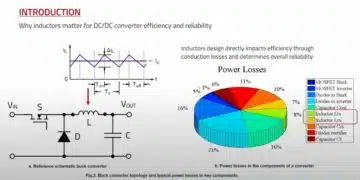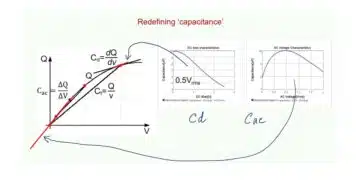This presentation from Würth Elektronik by Efrain Alzate provides a comprehensive overview of impact of electrical (elevated voltage) and thermal stresses (elevated temperature) to degradation of molded inductors by specific degradation mechanism called percolation phenomenon.
Molded inductors offer significant advantages in DC-DC converter applications due to their magnetic material properties, enabling smaller footprints and lower profiles.
This expands their applicability to more demanding environments where they face higher electrical and thermal stresses. Over time, these stresses can lead to a degradation of the insulation between magnetic particles, resulting in an undesirable increase in magnetic core losses. Würth Elektronik identifies this specific degradation mechanism as a percolation phenomenon.
- The precise definition and underlying mechanisms of percolation.
- A detailed analysis of how this phenomenon directly affects the long-term performance and reliability of DC-DC converters.
- The significant repercussions of the percolation phenomenon on inductor performance.
Introduction – What is Percolation Phenomenon
Molded power inductors have become indispensable in modern DC/DC converter applications due to their compact form factor, high current handling, and mechanical robustness. However, as switching frequencies increase and operating voltages rise, these inductors face new reliability challenges. One of the most critical degradation mechanisms is the percolation phenomenon, where insulation between magnetic particles breaks down under electrical and thermal stress, leading to increased core losses and reduced efficiency. This presentation explores the mechanisms, experimental findings, and design strategies to mitigate percolation in molded inductors.
Key Takeaways
- The Percolation Phenomenon degrades molded inductors by breaking down insulation under electrical and thermal stresses.
- This degradation leads to increased core losses, ripple current distortion, and reduced efficiency in DC-DC converters.
- Advanced testing and design strategies are essential to mitigate the effects of percolation, especially under high-stress conditions.
- Molded inductors are critical in applications like electric vehicles and renewable energy, facing significant reliability challenges.
- Understanding percolation helps ensure long-term stability and performance in demanding electronic applications.
Chapter 1: Market Trends and Application Context
The global market for molded inductors is projected to grow at a CAGR of 7% through 2030, driven by electric vehicles, renewable energy, and AI hardware. These applications demand higher power density and efficiency, forcing inductors to operate closer to their material limits. As a result, understanding long-term degradation mechanisms is critical for ensuring system reliability.
Chapter 2: Construction and Material Science
Molded inductors are fabricated by embedding magnetic alloy powders in a resin binder. Each particle is coated with an insulating layer to prevent eddy current formation. Under normal conditions, this structure provides stable inductance and low losses. However, elevated voltage and temperature can degrade the insulation, allowing conductive networks to form between particles.
| Material Property | Nominal Behavior | Degraded (Percolated) Behavior |
|---|---|---|
| Electrical Resistivity | High (insulating) | Reduced (conductive paths form) |
| Magnetic Losses | Predictable, frequency-dependent | Exponential increase with stress |
| Thermal Stability | Stable up to rated temperature | Accelerated self-heating |
Chapter 3: The Percolation Phenomenon
Percolation can be modeled as a resistor in parallel with the inductor. Initially, the effect is negligible, but once a critical threshold is reached, losses escalate rapidly. This transition is nonlinear and often irreversible. The ripple current waveform shifts from triangular to exponential, indicating increased conduction losses within the core.
Chapter 4: Experimental Observations
Stress testing at 200°C for 5,000 hours revealed significant degradation in inductors exposed to voltages above 190 V. The quality factor (Q) decreased by more than 50%, and ripple current distortion increased harmonics by up to 14 dB. Efficiency losses of 30–50% were observed in extreme cases, directly impacting converter performance.
Chapter 5: Ripple Current Distortion
Ripple current distortion is a key indicator of percolation. In healthy inductors, ripple current follows a triangular waveform. Under percolation, the waveform becomes exponential, increasing harmonic content and EMI emissions. This effect can destabilize feedback loops in DC/DC converters, leading to reduced efficiency and compliance failures.
Chapter 6: High-Temperature Stress Testing
High-temperature storage and operational stress tests are essential for evaluating inductor reliability. Traditional qualification at 100 kHz may overlook percolation effects, which become evident only at higher frequencies. Accelerated aging tests at 200°C demonstrated that inductors with weak insulation networks fail within 1–2 years of continuous operation, even when operated within datasheet limits.
Chapter 7: Design Strategies to Mitigate Percolation
- Use inductors with proven high-voltage insulation and thermal stability.
- Perform Q-factor measurements at multiple frequencies, not just 100 kHz.
- Derate inductors by 20–30% in high-stress applications (EV, AI servers).
- Implement thermal management strategies (heat sinks, airflow, PCB copper planes).
- Adopt predictive modeling using Arrhenius-based lifetime projections.
Conclusion
The percolation phenomenon is a silent but critical reliability challenge in molded power inductors. It directly impacts efficiency, EMI compliance, and long-term stability of DC/DC converters. By adopting advanced testing methods and conservative design strategies, engineers can mitigate risks and ensure robust performance in demanding applications. Future research should focus on improved insulation materials and predictive percolation models.
The percolation phenomenon occurs when the insulation between magnetic particles inside a molded inductor breaks down under elevated voltage and temperature stress. This creates conductive paths, leading to increased core losses, ripple current distortion, and reduced efficiency in DC/DC converters.
Percolation increases magnetic losses, distorts ripple current waveforms, and raises EMI emissions. This can reduce efficiency by up to 50% in extreme cases and may cause compliance failures in automotive and industrial applications.
Early signs include a drop in quality factor (Q), distorted ripple current waveforms, and increased harmonic content. High-frequency Q-factor measurements and accelerated stress testing are recommended to detect percolation before failure occurs.
Engineers can mitigate percolation by selecting inductors with high-voltage insulation, derating components by 20–30% in high-stress environments, implementing thermal management, and using predictive lifetime models such as Arrhenius-based projections.
How-to: Mitigate Percolation in Molded Power Inductors
- Select robust inductors
Choose molded inductors with proven high-voltage insulation and thermal stability, especially for automotive and industrial applications.
- Perform advanced testing
Go beyond standard 100 kHz qualification tests. Measure Q-factor at multiple frequencies and conduct accelerated aging tests at elevated temperatures.
- Apply derating
Derate inductors by 20–30% in high-stress environments such as EV powertrains or AI server boards to extend operational lifetime.
- Improve thermal management
Use heat sinks, airflow optimization, and PCB copper planes to reduce self-heating and delay percolation onset.
- Use predictive modeling
Adopt Arrhenius-based lifetime models to forecast degradation and plan maintenance or replacement cycles proactively.




